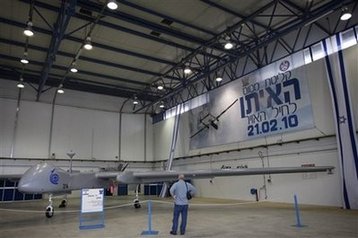Global General
Israel unveils new drone fleet that can reach Iran
(Agencies)
Updated: 2010-02-22 06:08
 |
Large Medium Small |
TEL NOF AIR FORCE BASE, Israel: Israel's air force on Sunday introduced a fleet of huge pilotless planes that can remain in the air for a full day and could fly as far as the Persian Gulf, putting rival Iran within its range.
The Heron TP drones have a wingspan of 86 feet (26 meters), making them the size of Boeing 737 passenger jets and the largest unmanned aircraft in Israel's military. The planes can fly at least 20 consecutive hours and are primarily used for surveillance and carrying diverse payloads.
 A visitor looks at an Israeli air force unmanned plane in the Tel Nof base, central Israel, Sunday, Feb. 21, 2010. [Agencies] |
"With the inauguration of the Heron TP, we are realizing the air force's dream," said Brig. Gen. Amikam Norkin, commander of the base that will operate the drones. "The Heron TP is a technological and operational breakthrough."
The commander of Israel's air force, Maj. Gen. Ido Nehushtan, said the aircraft "has the potential to be able to conduct new missions down the line as they become relevant."
Israel's military refused to say how large the new fleet is or whether the planes were designed for use against Iran, but stressed it was versatile and could adapt to new missions. The plane's maker, state-owned Israel Aerospace Industries, has said it is capable of reaching the Persian Gulf, which would put Iran within its range.
Israeli defense officials said the Heron TP could be a useful tool against Iran. It could provide surveillance, jam enemy communications and connect ground control and manned air force planes.
The officials requested anonymity because they were discussing sensitive military technology.
Israel considers Iran a strategic threat because of its nuclear program, long-range missiles and repeated references by its leaders to the Jewish state's destruction.
| ||||
In past conflicts, various types and sizes of unmanned planes have been used in missions like long-range surveillance and attacking enemy targets with guided missiles in conflicts like Iraq and Afghanistan, where anti-aircraft systems are rudimentary.
They have proven much less successful in conflicts where the opponents possessed better anti-aircraft weapons.
During NATO's aerial onslaught against Serbia in 1999, for example, Serbian quickly forces shot down 42 US drones, drastically reducing the effectiveness of the bombing campaign.
"We are aware of the dangers such an aircraft can meet in the battlefield, and we do whatever we can to protect it," said air force Lt. Col. Eyal.
Eyal, whose last name was not disclosed in line with military guidelines, would not comment on how the plane could protect itself from anti-aircraft systems.
Israeli defense analyst Shlomo Brom, a retired general and security expert at Tel Aviv University's Institute for National Security Studies, called the new drone a breakthrough.
"Its staying power and the height it can reach means it is able to cover ground continuously and it is able to cover large territory," he said.
Israel's military was the first to make widespread use of drones in its 1982 invasion of Lebanon, according to Mark Daly, an expert on unmanned aircraft at Jane's defense publications in London.
Israeli companies are considered world leaders in drone technology and now export unmanned aircraft to a number of armies, including US-led forces that have used them in Iraq and Afghanistan.
The Heron TP has been in development for about a decade, but the aircraft first saw action during Israel's offensive against Hamas militants in the Gaza Strip just over a year ago.
Drones were seen as crucial to the Gaza onslaught by giving soldiers eyes in the air, keeping watch over rooftops and alleyways in congested urban areas — notifying troops of threats or obstacles in their path.
Palestinian witnesses have long claimed that Israeli drones fire missiles in Gaza, both before and during the Israeli offensive. Israel has never confirmed that its unmanned aircraft are capable of firing missiles.
The military says the huge new drone will give an added element to Israel's ability to control its borders.










